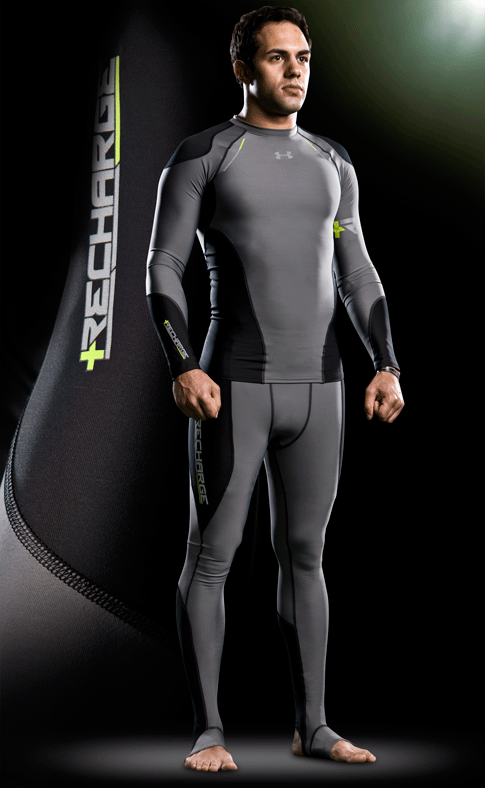Skin-Tight Compression Suit Promises Better Recovery
You have warmup gear and performance gear; now put on your after-suit

We may earn revenue from the products available on this page and participate in affiliate programs. Learn more ›
Under Armour was the first company to convince athletes to wear skin-tight clothing during competition. Now they want you to sleep in it. The Under Armour Recharge is a compression garment designed to be worn after a workout.
The Recharge, available July 15th, consists of a long-sleeve shirt ($99.99) and full-length pants ($89.99) with targeted compression in certain muscular regions. Athletes are instructed to change into the suit within two hours after a workout, and to continue wearing the garment for a full twenty-four hours.
According to Under Armour, those willing to sleep and shop in a skin-tight leotard will be rewarded handsomely during future fitness endeavors.
While UA won’t release quantitative data, they promise the following to those who wear the suit for just 24 hours:
- Significant reduction in muscle damage quantified by levels of creatine kinase in the blood
- A reduction in subjective fatigue level by 50 percent
- A reduction in subjective muscle soreness by 50 percent
- A reduction in muscle swelling based on ultrasound muscle thickness
- An increase in power based on bench-press throw
The suit may sound similar to an Adidas garment we covered a few months back. Under Armour is quick to emphasize that they claim no performance benefits during competition, unlike the Adidas Powerweb, which uses thermoplastic strips to provide a mechanical advantage. The Recharge is focused solely on recovery.
UA claims the Recharge’s compression system prevents water from rushing into the muscles, which can lead to post-workout swelling. They also cite, as one of the benefits of the Recharge, something a bit more ambiguous: “dynamic casting” that supports muscles and therefore facilitates healing. As with the Adidas garment, a certain posturing support is obvious when worn, but how this helps recovery is not as clear. UA also notes that other compression garments focus on increasing blood flow, which they believe is not something most athletes struggle with after a workout. It is reasonable to wonder, independent of what the different garments’ claim, whether others on the market would provide similar benefits if worn to bed under your flannel pajamas.
The suit is currently a one-sport-fits-all model, which seems illogical. Presumably, different sports would accentuate different muscle groups, requiring modified compression. It’s also uncertain how the effects of the suit vary for different body types of varying muscle size. You know, like for those of us who may not be as comfortable walking around Wal-Mart in head-to-toe Spandex…